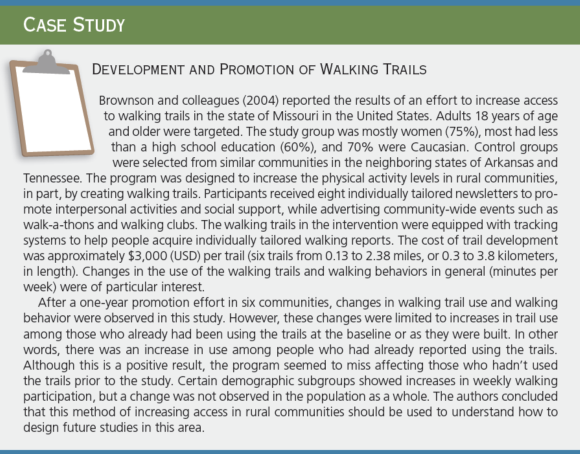Community-scale or macro-environmental urban design
This is an excerpt from Foundations of Physical Activity and Public Health 2nd Edition With Web Resource by Harold Kohl III,Tinker Murray & Deborah Salvo.
Community-scale or macro-environmental urban design strategies for promoting physical activity involve changes and enhancements to the built environment of urban areas of several square miles (or kilometers) or larger, which are usually defined as being an administrative unit (zip code, neighborhood, school district, city, or county). These kinds of approaches strive to make entire communities more amenable to physical activity, whether that activity is transportation-related or exercise performed in discretionary time. Strategies at this level of influence include connecting transportation arteries; creating landscaping and lighting to enhance the aesthetics and perceived safety of the entire community; building a large-scale and interconnected network of sidewalks, bicycle lanes, and trails; and designing new mixed-use residential areas so that destinations such as workplaces, schools, and areas for leisure and recreation are within safe walking or bicycling distances.
One important and unique macro-environmental urban design element is road connectivity. The concept of connectivity refers to the ease of getting from one place to another within a neighborhood using the city's road network to walk or bike. If city thoroughfares follow a grid pattern, it is easy to use the street network (assuming sidewalks or bicycle lanes are available) to move around on foot or on bicycle; however, if intersections are very far from each other or there are quite a few dead-end streets or culs-de-sac, connectivity is considered to be sub-optimal. Another related construct for the macro-environment that has emerged in the past couple of decades is walkability. Walkability refers to the conduciveness of walking for transportation based on features of the built environment of an urban area. Many researchers have proposed different definitions of walkability, using scores or indices. Some of these scores are even used by real-estate companies to provide their clients with information about potential neighborhoods. High walkability scores or indices could indicate the best mix of built environment elements, and if optimized, could point to a neighborhood that is very easy to navigate on foot. Likewise, neighborhoods with low walkability scores are those with suboptimal conditions for transport-based walking. Most available walkability scores or indices include measures of connectivity, land-use mix, and residential density, which are three critical components for optimal urban design that promote walking for transportation in an area. Although this definition for walkability is valid in many parts of the world, it is not applicable in others (e.g., Mexico or China) (Salvo et al. 2014; Lu et al. 2017). Therefore, it is always important to consider the local context, including the social environment (social norms and cultural values), when trying to promote walkable environments because these may look different in other parts of the world.
Studies examining community-scale changes for physical activity promotion have used a wide variety of outcome measures (Heath et al. 2006). Some have studied the absolute number of walking trips in a community over a given time period; others, the distance of those trips, minutes of walking per week, and number of pedestrians in a certain area. Although these outcomes are not entirely comparable, the general interpretation is that making the built environment more activity-friendly can improve levels of physical activity (regardless of how it is measured) by an average of more than 160%. Clearly, this is a major influence on physical activity habits in a community.



Get the latest insights with regular newsletters, plus periodic product information and special insider offers.
JOIN NOW


